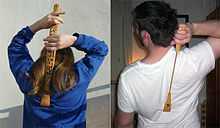Backscratcher

A backscratcher (occasionally known as a scratch-back) is a tool used, as the name would suggest, for relieving areas that cannot easily be reached just by one's own hands, typically the back.
Composition and variation
They are generally long slender rod-shaped tools good for scratching one's back, with a knob on one end for holding and a rake-like device, sometimes in the form of a human hand, on the other end to perform the actual scratching. Many others are shaped like horse hooves, claws, or are retractable, to reach further down the back. Though a backscratcher could feasibly be fashioned from most materials, most modern backscratchers are made of plastic, though examples can be found made of wood, whalebone, tortoiseshell, horn, cane, bamboo or occasionally ivory and narwhal tusks. Backscratchers vary in length between 12 and 24 ins. (30–60 cm.).
Recently, a new type of backscratcher has appeared in the market place. It is called a lanyard backscratcher or a shuttle backscratcher. It consists of a 6-7 foot lanyard, (a cord) usually in a bright color, with a shuttle scratching device in its center. The lanyard is flipped over the head with both hands, being pulled against the person's back. The shuttle is then gently pulled back and forth across and around the back, to reach the otherwise unreachable areas. It gives the user much greater control over the scratching pressure than traditional rod and claw scratchers. The improvement in the quality and firmness of the scratching is remarkably better, particularly for the elderly, the disabled, and those with limited or impaired arm movement. This new type of device allows for the scratching of a person's entire back in only a few seconds. It can also be used across the back of the neck and head, the buttocks and the back of the thighs.
Backscratchers through history
The first backscratchers were used by the Inuit and were carved from whale teeth. However, in recent history it was unquestionably also employed as a kind of rake to keep in order the huge "heads" of powdered hair worn by ladies in the 18th and 19th centuries.[1]
In the past, backscratchers were often highly decorated, and hung from the waist as accessories, with the more elaborate examples being silver-mounted, or in rare instances with an ivory carved hand with rings on its fingers. The scratching hand was sometimes replaced by a rake or a bird's talon. Generally, the hand could represent either a left or right hand, but the Chinese variety usually bore a right hand.[1]
Although not specifically used for only back scratching, young Chiricahua men in training and women going through a puberty ritual traditionally had to use a ceremonial wooden scratcher made from a fruit bearing tree instead of scratching with their fingernails or hands. Young men who did not use the scratcher for scratching were reported to develop skin that was too soft.[2]
Chinese farmers occasionally used backscratchers as a tool to check livestock for fleas and ticks as well.
References
- ↑ 1.0 1.1
 One or more of the preceding sentences incorporates text from a publication now in the public domain: Chisholm, Hugh, ed. (1911). "Backscratcher". Encyclopædia Britannica 3 (11th ed.). Cambridge University Press
One or more of the preceding sentences incorporates text from a publication now in the public domain: Chisholm, Hugh, ed. (1911). "Backscratcher". Encyclopædia Britannica 3 (11th ed.). Cambridge University Press - ↑ Opler, Morris E.; & Hoijer, Harry. (1940). The raid and war-path language of the Chiricahua Apache. American Anthropologist, 42 (4), 617-634.
External links
| Wikimedia Commons has media related to Backscratcher. |
- “The Scratch-Back,” at the end of August 19 in The Book of Days by Robert Chambers.